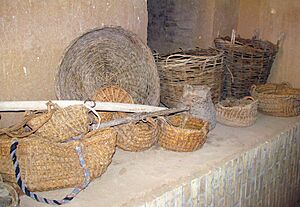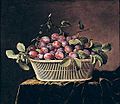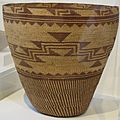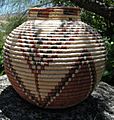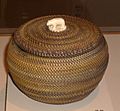Basket facts for kids
A basket is a special kind of container. It's usually light and easy to carry.
People who make baskets use many different materials. These can include tree bark, thin willow branches, leaves, wire, plastic, paper, and even rope. There are three main ways to make a basket: coiled, twined, or woven. A woven basket uses "spokes" (which go up and down) and "weavers" (which go over and under the spokes). A coiled basket is made by sewing rings of plant material together, one after another. Twined baskets have flexible weavers that are twisted around the spokes in different patterns.
Basket making is a very old skill. It's so ancient that you can find stories about it in myths from many different cultures around the world.
In the sport of basketball, the "basket" is an open net attached to a metal ring. Players try to throw the ball into this net to score points.
Contents
What Are Baskets Used For?

Baskets are used for many things, both practical and beautiful. Some baskets are even used in special ceremonies or religious events. Most often, baskets are used for storing things or carrying them from one place to another.
But there are also special baskets for other jobs. Some act like sieves to drain water. Others are used for cooking, or for preparing seeds and grains. You might find baskets used for tossing game pieces, as rattles, or as fans. Some are even made into fish traps or used for holding laundry.
The History of Baskets
Before people learned to weave baskets, they used simple containers made from tree bark. These bark containers were good for carrying food they had gathered. However, they would often fall apart after only a few uses. The next step was to weave strips of bark or other plants to make the bark containers stronger. After that, people started making baskets entirely from woven materials. The newest idea was to weave baskets so tightly that they could even hold water!
It can be hard for archaeologists (people who study old things) to find ancient baskets. This is because baskets are made from natural materials that often break down in the soil over time. But we do have some clues! Places in the Middle East show that weaving was used to make mats and possibly baskets around 8000 BCE. Twined baskets have been found from about 7000 BCE in a region called Oasisamerica. Baskets made with interwoven techniques became common around 3000 BCE.
Baskets were first made to be useful for many different tasks. They helped people carry and store items, and keep their homes tidy. The type of plants growing in an area often decided what materials were used for baskets. This, in turn, affected how the baskets were woven. For example, rattan (from the palm family), thin grasses, or broad-leaved tropical plants like bromeliads each need different twisting and braiding methods. Over time, making baskets has also become a form of art. This means basket makers can choose many colors, materials, sizes, patterns, and details to make unique creations.
For a very long time, especially in rural areas, women have carried baskets on their heads. You can even see this in Ancient Greek art, where statues of women carrying baskets on their heads are called Canephorae.
Materials Used for Baskets
Basket makers use many different materials. Here are some common ones:
Images for kids
-
President Lyndon B. Johnson with a basket of dogs.
-
Baskets at the Danforth Museum in Framingham, MA.
-
A set of traditional hand-woven baskets made by the Nuu-chah-nulth people (Indigenous people of Canada's Pacific Northwest Coast).
-
Baskets for sale on the island of La Réunion, east of Madagascar.
-
Straw hats and baskets for sale near the Luangwa turn-off in Zambia.
-
A storage basket made by the Pomo people (Indigenous people of California), at the Honolulu Museum of Art.
-
A trinket basket made by the Makah people of Northwest Washington, from the late 1800s to early 1900s. It's made from twined and plaited bear grass, sedge, and cedar bark.
-
An Ethiopian woman gathering coffee beans in a basket.
-
Bending vines for basket construction in Pohnpei.
-
An Inupiat basket made of whale baleen with a walrus ivory top, from Barrow, Alaska.
-
A black ash baby basket made by Odawa-Ojibwe artist Kelly Church from Michigan.
-
Yurok baskets from the Redwood National Park area in California.
-
Traditional western Hubei baskets from China.
-
A sweetgrass basket made by the Gullah culture from the coast of Georgia or South Carolina, USA.
-
A Backpack made from birch bark.
-
An Egyptian basket preserved in the Biblioteca Museu Víctor Balaguer, Vilanova i la Geltrú.
-
Modern bamboo baskets from Bangladesh.
See also
 In Spanish: Cesta para niños
In Spanish: Cesta para niños


